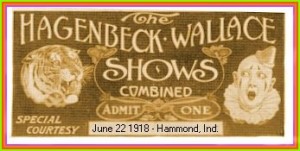
From Michigan Railroad History
Ivanhoe, 1918. It was almost 4 a.m. on Saturday, June 22, 1918. The second section of the Hagenbeck-Wallace circus train was rolling west on the Michigan Central main
line through Hammond. Its twenty-six cars included seven cars of animals in cages and four sleepers filled with some 300 performers and roustabouts.
Conductor R. W. Johnson thought he smelled an overheated journal–a hot box–and had the train brought to a stop just east of the Elgin, Joliet & Eastern
crossing at Ivanhoe on the east side of Hammond. Flagman Trimm dropped off and jogged back to protect the rear of his train against any train that might be
following. The train that was following was an empty troop train headed to Chicago that had left Michigan City 27 minutes after the circus train. Engineman
Alonzo Sargent, an experienced man at the throttle, had had little or no sleep in the last twenty-four hours. The effects of a heavy meal, some kidney pills,
and the gentle rolling of his locomotive made him drowsy. On that clear night flagman Trimm could see the approaching headlight of the troop train. It rolled
past a yellow caution signal, then a red stop signal set by the circus train.
Trimm waved his lantern frantically, then threw a fusee in an attempt to stop the troop train. Sargent realized his peril when he saw the red marker lights of
the train directly in front of him. But by then there was no stopping. His engine, rolling at about thirty miles per hour, plowed into the circus train.
Cars telescoped into one another. The kerosene lanterns in the sleeping cars caused the old wooden cars to burst into flames. There was no water to douse the
fires and one performer after another perished in the disaster. Relief trains came as soon as possible to give what relief could be given. Survivors were
transported to the Hammond and its hospital. The final count was awful.
Sixty-eight had been crushed, suffocated, or burned; one hundred twenty-seven went to the hospital. The city of Hammond turned out and gave all the help it
could. Most of those killed, many of them burned beyond recognition, were buried in Woodlawn Cemetery, at the intersection of Cermak Road and Des Plaines
Avenue in Forest Park, Illinois, in a section set aside as Showmen’s Rest. Few of those buried were identified and their graves are marked “Unknown Male” or
“Unknown Female.” One grave is marked “Smiley,” one “Baldy”, and another “4 Horse Driver.” This wreck is described in fuller detail in Stewart H.
Holbrook’s The Story of American Railroads (New York, 1947), pp. 284-287. ….MORE
More from Hammond Indiana City Guide